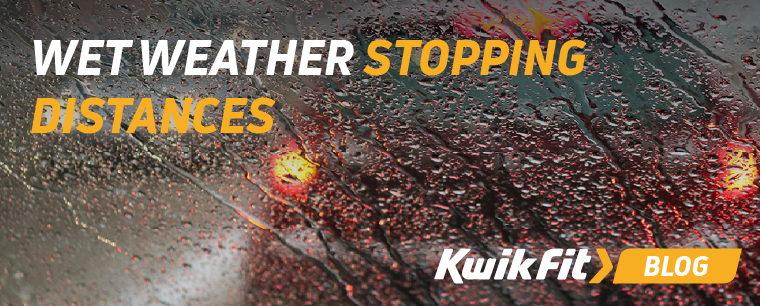Wet Weather Stopping Distances
Kwik Fit | Wednesday 12th February 2025 3:00pm

Knowing your stopping distances is critical for vehicle safety. Many factors influence stopping distance including the weather, temperature and the tyres themselves.
While these factors play a key part in the time and distance it takes to bring your vehicle to a safe stop, being aware of how you drive in wet weather conditions will significantly aid your stopping distance and will keep you safer on the road too. At Kwik Fit, we’re here to offer help and advice so you can be the most safe and confident driver, no matter what the weather’s doing. Read on to learn more.
What is 'stopping distance?'
Many drivers believe stopping distance is the distance that a vehicle travels after the brake has been applied. However, this is actually only the braking distance. Although this makes up a large part of stopping distance, ‘thinking distance’ also contributes. Thinking distance refers to the time it takes you to decide that you need to brake in the first place.
Your thinking distance is influenced by factors both within your vehicle and externally, including:
- Alertness: Depending on your alertness, you will be able to react quicker. Driving whilst being tired or distracted will slow down your response times.
- Driving conditions: If you are driving in rainy conditions where visibility may be poor, your thinking distance will be negatively affected.
- Speed: The quicker your speed, the longer your stopping distance.
- Tyre conditions: The condition of your tyres also significantly influences your ability to brake quickly. Factors including tyre damage and lack of tread depth will reduce your vehicle’s ability to brake efficiently.
In short, your stopping distance is your thinking distance and your braking distance combined — from the moment you want to brake to the moment your car is fully stationary.
How does wet weather affect my stopping distance?
Wet weather conditions can affect many aspects of your journey. Compared to dry conditions, wet driving can double your stopping distance, meaning that, as a driver, you will have to be twice as vigilant.
Stay aware of the following:
- Wet surfaces: Wet conditions means there is a layer of water between your tyres and the road. This means there is less resistance, and consequently it takes more time for your car to come to a full stop.
- Lower visibility: Dark or murky conditions make it harder to see what’s going on on the road. With low visibility, you’ll have less time to see what’s up ahead — and, therefore, potentially less time to apply the brake.
- Hydroplaning: Whilst trying to brake in wet weather, your vehicle can hydroplane, or aquaplane, and this can be dangerous. This happens when your tyres lose all contact with the road and are unable to displace the water, so they lose control.

Can winter tyres help in wet weather?
In the UK, most drivers use summer tyres, such as Continental’s PremiumContact™ 6, and don’t look to change their tyres for the colder, wetter months. In comparison, in Europe, it’s common for drivers to switch to winter tyres towards the end of each year. In some European countries, it is even a requirement for drivers to make this change.
People often mistakenly believe that winter tyres are only appropriate for snowy conditions and, because we don’t often get snow in the UK, many drivers decide not to make the change to winter tyres at all. However, snow is not the only reason to use winter tyres. The main factor is temperature.
As soon as the temperature gets down to 7°C and below, stopping distances are significantly shortened for vehicles fitted with winter tyres compared to those with summer tyres.
The difference between winter and summer tyres is that winter tyres are made from different compounds, designed to perform better at lower temperatures. The compounds used for summer tyres become too hard and contracted below 7°C and, as a result, they have less grip than their winter counterparts. Likewise, winter tyres are made of softer compounds and aren’t designed to cope with temperatures above 7°C.
The best of both worlds?
All season tyres aim to offer an alternative to summer and winter tyres. By combining their characteristics, manufacturers are able to make a tyre that's suitable for all weather conditions.
However, as they are not specifically designed for a particular weather type, they will not perform as well as winter and summer tyres in their respective seasons. Nonetheless, all season tyres can provide good performance all year round, especially in countries such as the UK with a moderate climate.
Stay safe in all weathers with Kwik Fit
Rain or shine, get your car ready for all occasions with Kwik Fit. From free tyre and brake checks to comprehensive servicing offerings, we’re here to make sure your car is always in tip-top condition - helping to keep you, and other road users, safe. Find your nearest centre today, and make sure you stay up to date with our blogs and guides for more advice.
Any facts, figures and prices shown in our blog articles are correct at time of publication.
Featured Articles
Is it Illegal to Drive With One Headlight?
Saturday 19th July 2025
Wondering if it’s illegal to drive with one headlight? Learn about the safety risks and penalties of illegal blown bulbs and why you should fix them promptly.
Air Con in EVs & Hybrids: Experts Answer Your Questions
Monday 30th June 2025
Does air con drain EV batteries? Can you use the air con while charging an electric car? Find out the answers to these questions & more from Kwik Fit’s experts.
Why Is Your Car Making a Noise? Fixes & Tips
Friday 13th June 2025
When your car starts making unexpected noises, it can certainly be quite disconcerting; it may be nothing to worry about, but here’s what you need to know.









